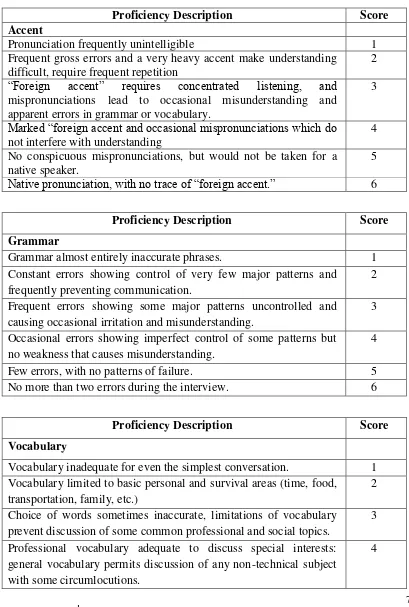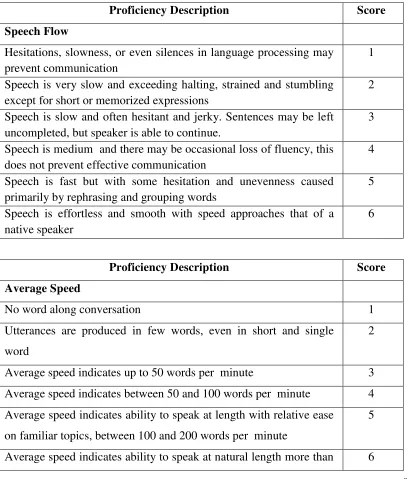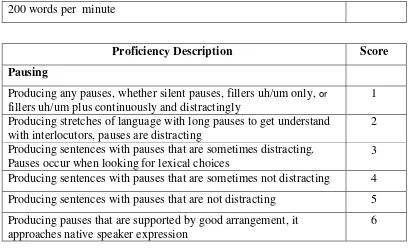CHAPTER III
METHODOLOGY
This chapter is going to elaborate several items which related to the method of
the study. They are included research design, population and sample of the research,
research site, instruments of the research, data collection procedure, and data analysis.
3.1 Research Design
The design of this research was quasi experimental study (time series design).
Quasi-experimental design that consisted only experimental class without control
class. Ary, et.al. (1979) defines quasi-experimental design as the design which would
have two choices either uses control group or not. Sugiyono (2006) says that time
series design is one of the quasi experimental design that only used experimental
class without a control group. Creswell (2012) states that time series design is a
design which only uses one group with multiple pre-test and post-test. The design of
this study can be seen in the following scheme:
Table 3.1 Research Design
Time Series Design
Select Pre Test Pre Test Pre Test Treatments Post Test Post Test Post Test
Participants
Ary et al. (2010) also states that in the one-group pretest–posttest design
usually involves three steps: (1) administering a pretest measuring the dependent
variable; (2) applying the experimental treatment X to the subjects; and (3)
administering a posttest, again measuring the dependent variable. Differences
attributed to application of the experimental treatment are then evaluated by
3.2 Population and Sample
Ary, et.al. defined population as all members of any well defined class of
people, events or objects. The population of this research was all of the second grade
students in one of the vocational high schools in Cimahi who were registered in
academic year 2015/2016. It was considered homogeneous because all the
populations were not based on ranking.
3.3 Sample
The sampling technique of this research was the purposive sampling. It means
that in determining the sample class was based on the purpose of the study. In this
study, the researcher used class XI KP B as the experimental because all the classes
have the same level in terms of ability. There was not favorite class.
3.3 Research Site
This study took place at one vocational high school in Cimahi, West Java. The
research site was chosen because it is accessible since the researcher is one of the
English teachers in this site. In this regard, the researcher knows that Task-Based
Language Teaching (TBLT) has not been applied, especially in teaching speaking.
3.4 Instruments of the Research
The research instruments being applied in this study for quantitative data
collection comprised lesson plans, English speaking test, criteria of speaking
ability for evaluating speaking ability, speaking observation form, and students’
opinion form.
3.4.1 Lesson plans
The lesson plans were designed along the following procedures:
1. The researcher studied the 2006 English Curriculum/syllabus, Standard
Process /Activities, Assessment/Evaluation, Time Allotment, and
Sources of Learning.
2. The researcher selected the Basic Competency (KD) which are relevant
to the objective of the study including:
1. Giving suggestion and offering
2. Giving opinion
3. Wish and hope
4. Procedural Text
3. The researcher designed the lesson plan based on the Task-Based Lesson
Plan framework proposed by Willis (1998) which consists of Pre-Task, Task
Cycle, and Language Focus.
3.4.2 English speaking tests
The speaking test comprised pre-test and post-test to measure students’
speaking ability. They were intended to find out whether Task-Based Language
Teaching (TBLT) was effective in improving the students’ speaking ability. The
speaking tests consisted of pre-test and post-test. In this case, the pre test was carried out to identify the learners’ initial ability in speaking skill. Therefore, it was given in the first meeting to find out the students’ ability before they got involved in the treatment. There were five tasks with different language functions and
situations, including Giving suggestion and offering, Giving opinion, Wish and
hope, and Procedural Text.
Post-test was basically conducted in the same way to the pre-test. It was
conducted after the students get the treatment. It was used to measure how effective
the treatment of teaching speaking by using Task-Based Language Teaching
(TBLT). The post-test items were the same in both pre and post tests.
required to have the conversation related to the procedure text and convey the
expression of giving suggestion and asking someone to do something. This text was
used since in SKL speaking activities required students to express interpersonal and transactional texts. Speaking (oral) test was used to measure the students’ ability in speaking for four reasons.
First, oral testing was an important part of an overall assessment program,
especially when communicative language proficiency was the goal of instruction.
Test of oral performance was important to resemble authentic language use as much
as possible (Hadley 2001). Second, oral test was important to be conducted as an
attempt to know the students’ ability to comprehend the meaning in a variety of
tasks; therefore, the students received a single score reflecting their performance
(Douglas in Hughes, 2002).
Third, oral tests in pairs were used in this study since the effective way of
assessing a students’ ability to speak was to give works in pairs or groups. Working
in pairs, students can describe their own ability in create the dialogue (Heaton,
1995). Pair tasks have many advantages. However, they are also challenges. The examinees’ talk is almost inevitably influenced by the other participant’s personality, communication style, and language level. Therefore, there is a
possibility that all test takers may not get an equal opportunity to show their
speaking skills at their best (Weir, 1993; Iwashita, 1999) in Luoma (2004).
The speaking test that was used in this research should be valid and
reliable. As stated by Sugiyono (2012), a good instrument (whether test or non
test) must be valid and reliable. By using valid and reliable instruments in
collecting the data, it is highly expected that the results of the study will be valid
and reliable too.
In term of validity, Hatch & Farhady (1982, p. 251) explain that validity is
divided into three types. The first type is content validity. It concerns with how well
the test represents the content or behavior to be tested. The second type is
criterion-related validity. It concerns with how well test performance predicts some
third type is construct validity. It concerns with whether or not the test
performance can describe the psychological factors related to the test performance
(e.g., self-concept, anxiety).
Moreover, reliability can be defined as the extent to which a test produces
consistent results when administered under similar conditions (Hach & Farhady
1982, p. 244).
3.4.3 Classroom Observation sheet
The second instrument was classroom observation sheet which was used to
know and observe what the teacher and students were doing in the classroom. And it
was also used to find out the phenomena happened during the implementation of
Task-Based Language Teaching approach in the speaking class of procedural text.
3.4.4 Note Taking
Note taking was an instrument that was used to take notes about what is
going on in the classroom from beginning of the lesson until the end of the
lesson. In this case, it has included note the application of Task-Based Language
Teaching in speaking activities.
3.4.5 Handy Camera
Handy camera was an instrument which was used to record what was
happening in the classroom. It could be as a proof that the research was conducted
in the classroom. Besides, it was also used to know how the implementation of
Task-Based Language Teaching in speaking English.
3.5 Data and Technique of Data Collection
3.5.1 Data collection
Data collection of this research comprised of qualitative data and
quantitative data. Qualitative data could be seen from the result of observation
more information about the implementation of Task-Based Language Teaching
in speaking English. Then, it could be seen from teaching and learning process
and how the problems that faced by the students could be solved. While,
quantitative data could be seen from speaking test. In this case, the result of
evaluation test was as the consideration in cultivating the quantitative data. The
quantitative data elaborated about the result of accuracy and fluency in
speaking.
3.5.2 Technique of Data Collection
Techniques of data collection of this research can be illustrated as
follows:
1. Observation
Observation sheet was made as a guidance in observing the students.
The researcher knew activities during the implementation of Task -Based
Language Teaching. Then, it was not only the application of this
approach which was observed, but also the speaking accuracy and
fluency of students in speaking English.
2. Giving a test
There were two kinds of tests that will be given to students. Those
were pre-test and post-test. Pre-test was given in the beginning before
doing the research. It was used to know the background knowledge of
the students. Next, the post-test was a test which was given at the end of
the research. It was used to find out the progress of students in speaking
English and whether students developed their speaking achievement or
not after Task-Based Language Teaching implemented.
3.6 Marking Schema
Table 3.2 Band score of oral testing criteria for accuracy
Proficiency Description Score
Accent
Pronunciation frequently unintelligible 1
Frequent gross errors and a very heavy accent make understanding difficult, require frequent repetition
2
“Foreign accent” requires concentrated listening, and mispronunciations lead to occasional misunderstanding and apparent errors in grammar or vocabulary.
3
Marked “foreign accent and occasional mispronunciations which do not interfere with understanding
4
No conspicuous mispronunciations, but would not be taken for a native speaker.
5
Native pronunciation, with no trace of “foreign accent.” 6
Proficiency Description Score
Grammar
Grammar almost entirely inaccurate phrases. 1
Constant errors showing control of very few major patterns and frequently preventing communication.
2
Frequent errors showing some major patterns uncontrolled and causing occasional irritation and misunderstanding.
3
Occasional errors showing imperfect control of some patterns but no weakness that causes misunderstanding.
4
Few errors, with no patterns of failure. 5
No more than two errors during the interview. 6
Proficiency Description Score
Vocabulary
Vocabulary inadequate for even the simplest conversation. 1 Vocabulary limited to basic personal and survival areas (time, food,
transportation, family, etc.)
2
Choice of words sometimes inaccurate, limitations of vocabulary prevent discussion of some common professional and social topics.
3
Professional vocabulary adequate to discuss special interests: general vocabulary permits discussion of any non-technical subject with some circumlocutions.
Professional vocabulary broad and precise; general vocabulary adequate to cope with complex practical problems and varied social situations.
Table 3.3 Band score of oral testing criteria for fluency
Proficiency Description Score
Speech Flow
Hesitations, slowness, or even silences in language processing may prevent communication
1
Speech is very slow and exceeding halting, strained and stumbling except for short or memorized expressions
2
Speech is slow and often hesitant and jerky. Sentences may be left uncompleted, but speaker is able to continue.
3
Speech is medium and there may be occasional loss of fluency, this does not prevent effective communication
4
Speech is fast but with some hesitation and unevenness caused primarily by rephrasing and grouping words
5
No word along conversation 1
Utterances are produced in few words, even in short and single
word
2
Average speed indicates up to 50 words per minute 3
Average speed indicates between 50 and 100 words per minute 4
Average speed indicates ability to speak at length with relative ease
on familiar topics, between 100 and 200 words per minute
5
200 words per minute
Proficiency Description Score
Pausing
Producing any pauses, whether silent pauses, fillers uh/um only, or fillers uh/um plus continuously and distractingly
1
Producing stretches of language with long pauses to get understand with interlocutors, pauses are distracting
2
Producing sentences with pauses that are sometimes distracting. Pauses occur when looking for lexical choices
3
Producing sentences with pauses that are sometimes not distracting 4
Producing sentences with pauses that are not distracting 5
Producing pauses that are supported by good arrangement, it approaches native speaker expression
6
(Cauldwell, 2005:9).
The way of calculating final accuracy and fluency:
Table 3.4 Students’ classification in Speaking Achievement
Classification Value Speaking Achievement (%)
Very High 8-10 80-100
High 7-7.9 70-79
Enough 6-6.9 60-69
Low 0-5.9 0-59
3.7 Hypothesis
There are two hypothesizes that proposed in this thesis:
Ho (null hypothesis): There is no different effect in the use of Task-Based Language
Teaching in the experimental group on the students’
speaking ability
H1 (alternative hypothesis): There is a different effect in the use of Task-Based
Language Teaching the experimental group on the students’
speaking ability
3.8 Concluding Remarks
This chapter has discussed the methodology of the research. It included
research design, research site and participant, data collection techniques, data
analysis techniques, and hypothesis. Chapter IV will elaborate the findings and


